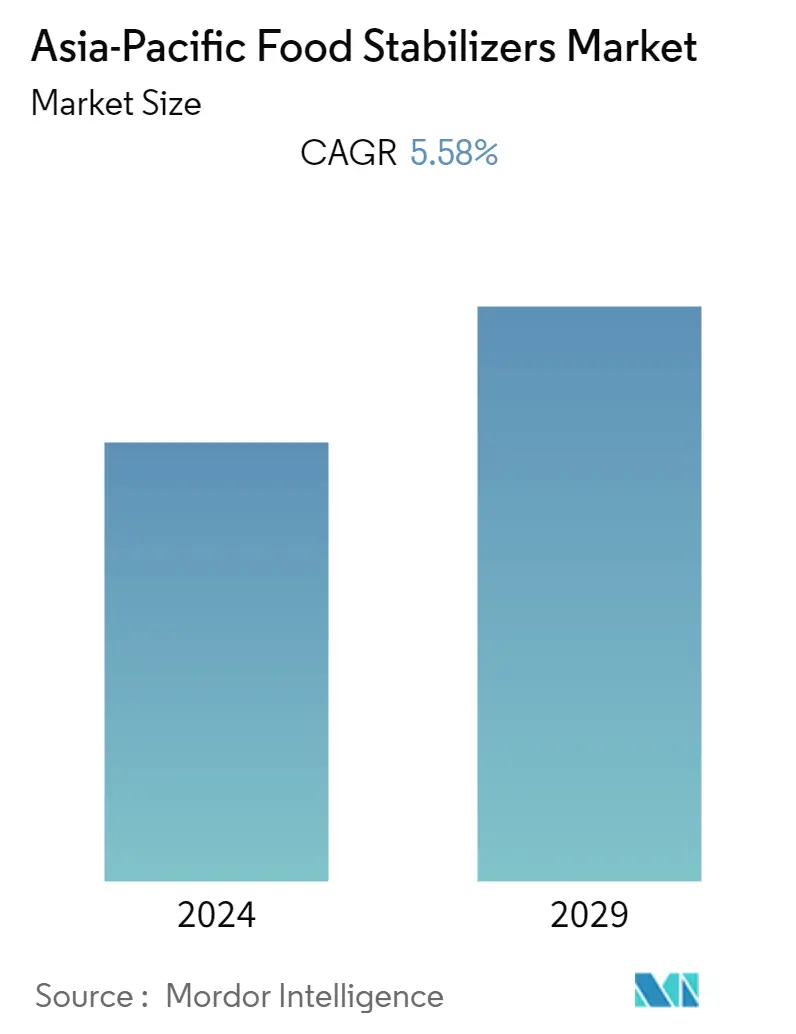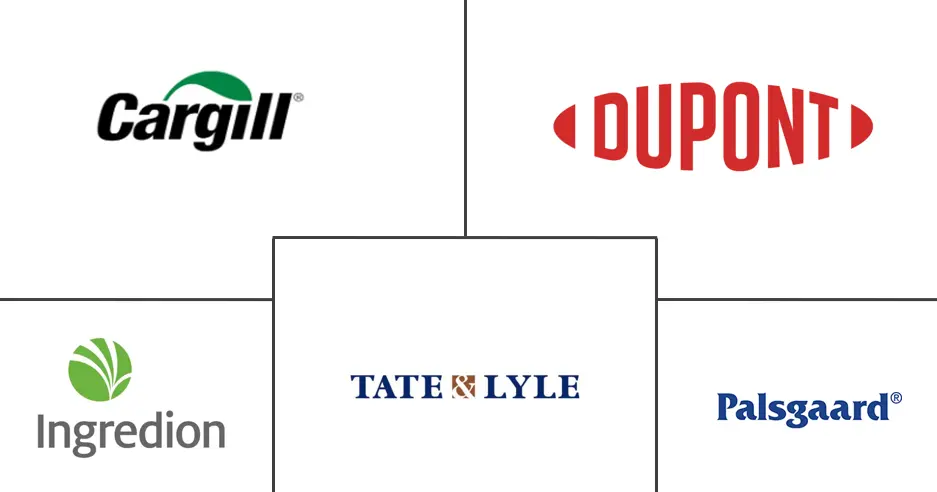Market Size of Asia-Pacific Food Stabilizers Industry

| Study Period | 2019 - 2029 |
| Base Year For Estimation | 2023 |
| Forecast Data Period | 2024 - 2029 |
| Historical Data Period | 2019 - 2022 |
| CAGR | 5.58 % |
| Market Concentration | Low |
Major Players
*Disclaimer: Major Players sorted in no particular order |
APAC Food Stabilizers Market Analysis
The Asia-Pacific food stabilizer market is projected to grow at a CAGR of 5.58% during the forecast period (2020-2025).
- The increasing consumption of ready-to-eat and ready-to-drink beverages has propelled the application of food stabilizers in the market in the Asia-Pacific region. The market is further boosted by the burgeoning demand for convenience food and organic food across.
- Technological advancements have led to the development of various stabilizer blends, which are not only multi-functional, but also cost-effective at the same time. Continuous innovations in the food stabilizer market are anticipated to offer potential opportunities to manufacturers across the region.
- The varying regulations pertaining to the approval of food stabilizer ingredients and the restrictions associated with the amount and dosage of ingredients in the final product are the key restraining factors to the market growth.
APAC Food Stabilizers Industry Segmentation
The Asia-Pacific food stabilizer market has been segmented by source into natural and synthetic sources of stabilizers. Natural stabilizers can be further bifurcated into the plant, microbial and animal-sourced food stabilizers. By application, the market is segmented into bakery &
confectionery, dairy, meat & poultry, beverages, sauces & dressings, and others. The geographical segmentation includes countries - China, Japan, India, Australia, Rest of Asia-Pacific.
| By Source | |||||
| |||||
| Synthetic |
| By Application | |
| Bakery & Confectionery | |
| Dairy | |
| Meat & Poultry | |
| Beverages | |
| Sauces & Dressings | |
| Others |
| By Geography | |
| China | |
| Japan | |
| India | |
| Australia | |
| Rest of Asia-Pacific |
Asia-Pacific Food Stabilizers Market Size Summary
The Asia-Pacific food stabilizers market is experiencing significant growth, driven by the rising consumption of ready-to-eat and ready-to-drink products. This trend is further amplified by the increasing demand for convenience and organic foods. Technological advancements have facilitated the creation of multifunctional and cost-effective stabilizer blends, offering manufacturers in the region substantial opportunities. However, the market's expansion is hindered by varying regulations regarding the approval and dosage of stabilizer ingredients. Beverages represent one of the fastest-growing segments within this market, as stabilizers like xanthan gum, carrageenan, and pectin are extensively used in low-calorie drinks, fruit juices, and other beverages to enhance taste and texture while minimizing sweetener usage.
China plays a pivotal role in the Asia-Pacific food stabilizers market, particularly with its substantial production of pectin, although it still struggles to meet domestic demand due to low material utilization rates. The country's infrastructure improvements in research and development are gradually enhancing its ability to produce new products and flavors. Kappa carrageenan is widely used in China for its stabilizing and emulsifying properties in various food products. The market is characterized by fragmentation, with numerous global and domestic companies such as Tate & Lyle PLC, Cargill, Incorporated, and DuPont de Nemours, Inc. competing for market share.
Asia-Pacific Food Stabilizers Market Size - Table of Contents
-
1. MARKET DYNAMICS
-
1.1 Market Drivers
-
1.2 Market Restraints
-
1.3 Porter's Five Force Analysis
-
1.3.1 Threat of New Entrants
-
1.3.2 Bargaining Power of Buyers/Consumers
-
1.3.3 Bargaining Power of Suppliers
-
1.3.4 Threat of Substitute Products
-
1.3.5 Intensity of Competitive Rivalry
-
-
-
2. MARKET SEGMENTATION
-
2.1 By Source
-
2.1.1 Natural
-
2.1.1.1 Plant
-
2.1.1.2 Microbial
-
2.1.1.3 Animal
-
-
2.1.2 Synthetic
-
-
2.2 By Application
-
2.2.1 Bakery & Confectionery
-
2.2.2 Dairy
-
2.2.3 Meat & Poultry
-
2.2.4 Beverages
-
2.2.5 Sauces & Dressings
-
2.2.6 Others
-
-
2.3 By Geography
-
2.3.1 China
-
2.3.2 Japan
-
2.3.3 India
-
2.3.4 Australia
-
2.3.5 Rest of Asia-Pacific
-
-
Asia-Pacific Food Stabilizers Market Size FAQs
What is the current Asia-Pacific Food Stabilizers Market size?
The Asia-Pacific Food Stabilizers Market is projected to register a CAGR of 5.58% during the forecast period (2024-2029)
Who are the key players in Asia-Pacific Food Stabilizers Market?
Tate & Lyle PLC, Cargill, Incorporated, Ingredion Incorporated, Palsgaard A/S and DuPont de Nemours, Inc. are the major companies operating in the Asia-Pacific Food Stabilizers Market.

